#marvelous
Howdy, everyone! I hope you’re all having a wonderful holiday season.
While we still haven’t announced a release date for Story of Seasons: Trio of Towns, we’re hoping to share more and more of the game with you over the coming weeks.
People play Story of Seasons games for several reasons, and one of the biggest (and most obvious) is as a farming simulation.
I played these games for years and years before actually trying my hand at real-world farming, so I had a rather idealized image of working the fields. A few years ago I got to know a Japanese farmer, who once let me dig for sweet potatoes in his fields. I split a few in half with the hoe, and he posted pictures of my shame on Facebook for his farmer friends to laugh at. So I retreated back to Story of Seasons, where you don’t even need a hoe to harvest root vegetables!
But I digress…
Unlike in the previous Story of Seasons title, all of the farmland in Trio of Towns is concentrated in the same area, so you won’t be running around the map in order to get to your beehives and flower fields and whathaveyous. And while you won’t have to compete against your wealthy and established neighbors for field space, you’ll have to earn expansions to your fields as your progress through the game.
Actually taming your farmland will require more than just the usual weeding, chopping, and hammering of obstacles—you’ll also need to order “Farm Circles” from Ludus, the dreamy handyman in Lulukoko, and arrange them on your farm. As long as you have open space free of trees and boulders, you will have a lot of freedom as to how to arrange your farm and what to produce.

Farming is hard work and trees are stamina-devourers early in the game. One of the best ways to restore your stamina is to buy a meal at Westown’s Garden Grill.
Here are some things you can do on your farm:
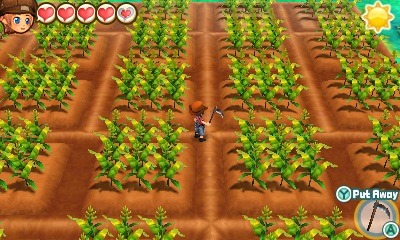
Plant rows and rows of corn. Scarecrow (and crows) not included.

Grow fruit trees.

Harvest mushrooms and paddy crops like wasabi and rice.
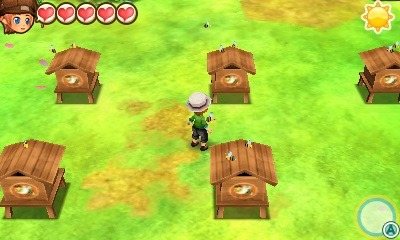
Equip the flamethrower. (Just kidding. Bees are our friends!)

And, of course, raise lots and lots of livestock.
Diversifying your farm’s output is essential to progressing the story of the game, a major part of which is building your bonds with the titular trio of towns and helping to revitalize them. These bonds are represented by the Town Link Rank, a gauge that fills up as you do things like participate in festivals, greet townsfolk, and complete part-time jobs. One easy way to improve your ranking with a particular town is to ship crops there by changing the “destination” on your farm’s shipping box. Improving your Town Link Rank will unlock story quests where you can help your neighbors improve their town. Completing these will pay big dividends for your farm in many ways. But I don’t want to give too much away…
Trio of Towns localization blog gaiden: fruits or vegetables?
“Junpei, are strawberries vegetables?”
This was a question I posed to one of my Japanese colleagues here at XSEED, based on an interesting classification in Trio of Towns.
Strawberries, melons, watermelons and pineapples are all classified as “vegetables” in the Japanese version and, to some extent, in the Japanese worldview. (Junpei’s answer to my question, which was asked entirely without context, was “Yes.”)
The reasoning is that these crops don’t grow on trees. While some cursory Wikipedia research has taught me that there are conflicting ways to classify these crops, strawberries, melons, watermelons, and pineapples are generally thought of as fruits in North America. This led us to an interesting localization dilemma.
In other cases, the simple solution as localizers would have been to reclassify these crops in their descriptions, writing “fruit” instead of “vegetable.” However, in Trio of Towns, “vegetables” and “fruits” are categories that are counted separately in things like shipping totals. This issue was managed by renaming the categories themselves from “veggie” and “fruit” (which, in Japanese, was actually “fruit tree”) to “Field Crop” and “Tree Crop.” We were then able to describe crops in the same category as fruits or vegetables in the item description text. I know that “Field Crop” and “Tree Crop” aren’t perfect, but they were the best we could come up with after a lot of discussion, and I’m satisfied with them as general categories.
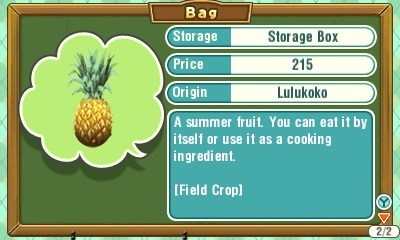
This might seem like a minor issue to all of you, but at the core of all of this was a fundamental gameplay problem related to an event. In tropical Lulukoko Village, where most of the seeds you can buy from the general store are for fruit trees, there is a special festival called the “Fruit Fiesta.” For this event, you can give fruits to Lulukoko villagers and receive fruits in return.
However, because of the classification system, players who gave strawberries, melons, watermelons, and pineapples would get no special response from the Lulukoko residents. (To say nothing of precious fruit in return!) I was certainly surprised by this on my playthrough of the game’s Japanese version, and we thought it would be disorienting for Western players. Sadly, simply changing the name of the category wasn’t a solution to this problem. We had to take it to the Japanese developers.
Working with our supportive colleagues in Japan, we submitted a proposal with a summary of the issue and several potential workarounds. The developer team accepted our solution of changing the category names AND making it so that these four “vegetables” would be available to give as presents during the Fruit Fiesta.
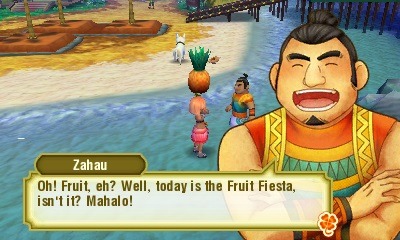
In the Japanese version of the game, you wouldn’t get a special response from Zahau here.
A lot of times when people ask us about the nitty-gritty of localization, their questions have to do with how we render idiomatic expressions or poetic language in English. While this is a big part of the challenge in going from Japanese to English, this case deals with more fundamental conceptual difference that had an actual impact on gameplay. Working on a solution with my colleagues at XSEED and in Japan was rewarding and even kind of fun.
That’s all for today (and for 2016). Future localization blogs will focus on pets, events, and those lovely bachelors and bachelorettes. Be sure to like our Story of Seasons Facebook page for screenshots, trailers, and other special updates we won’t always be posting to this blog.
Until next time, have a happy holidays and a wonderful new year!

Howdy, everybody!
Welcome to what I think will be the final localization blog for STORY OF SEASONS: Trio of Towns. As you might have seen, we announced a release date (Nov. 9) and price ($7.99) for the Trio of Towns DLC. We are also, at long last, able to release the Trio of Towns 3DS theme on the North American eShop for $1.99. I apologize for the drought of information between our last blog post and now. Production proved to be challenging in unforeseen ways, and we didn’t want to give out new info before we were certain the content was ready to be released.

A scene from one of the DLC events.
I’d like to use this blog to lay out all the content that will be released next Thursday.
Patch
The Version 1.1 patch will either be automatically downloaded to your 3DS system, or you can find it on the eShop and download it from there.
In addition to the bug fixes and text corrections mentioned in our previous blog, this patch will add four outfits. These include Lest and Frey’s outfits from our 2013 release Rune Factory 4. We wanted to distribute these outfits to all players as thanks for their support of Trio of Towns, and their patience during the development of the game’s extra content. Once the update is installed, the new clothing items will be available for purchase at Ludus’ shop (the Rune Factory 4 outfits) and the wholesale store in Tsuyukusa (the Perfect Dress and Poodle outfits).
I’m including screenshots of the ingredients needed to make each, so those of you who want to cosplay Lest/Frey (or voice actress Ayana Taketatsu, who inspired the Perfect outfits) can start getting the materials together.

Princess’ Attire

Prince’s Attire

Perfect Top Hat

Perfect Dress

Poodle Hat
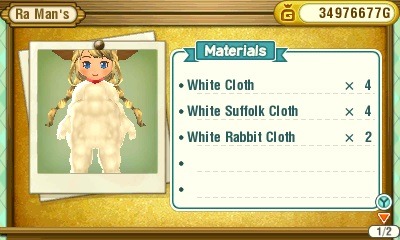
Poodle Costume
DLC
Once you’ve downloaded the 1.1 patch, the DLC, called the “New Neighbors Pack,” will be purchasable from a newly added “Downloadable Content” menu on the title screen.
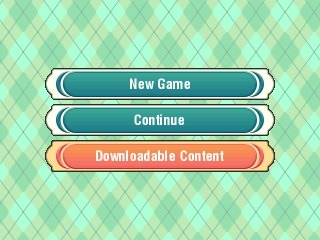
Follow us for more thrilling screenshots of menus!
We decided to roll all of the content into one DLC package, which allowed us to reduce its cost from our original estimate to $7.99. This “New Neighbors Pack” is the only DLC for the game, and will contain almost* everything from the four post-launch Japanese patches:
- Marriage candidates Woofio and Stephanie
- The ability to have a child with Inari
- Events such as cultural exchanges among the three towns and a visit from your father
- Events immediately following the New Year’s Festival and Starlight Gala
- About 50 new lines of dialogue per marriage candidate, including clothing/pet reactions
- 5 special winter outfits
- A performer story
We’ve posted lots of screenshots from this content on the STORY OF SEASONS Facebook page over the past few months. For more information on Woofio and Stephanie, be sure to check back there next week.
If you were wondering, players with the retail game, the patch, and the DLC can all play online with one another without issue. The new outfits will just show up as the default outfit if you are playing on a version without the added data.
*As with Hamtaro, we were unable to secure the rights to use Chebrashka, so this little Russian character is missing from our release.
Theme
This theme features the bachelors and bachelorettes (sadly, it is missing Woofio and Stephanie), and plays one of the romance event songs. You can purchase it (and the STORY OF SEASONSandRune Factory 4) themes from the Theme Shop on your Nintendo 3DS.
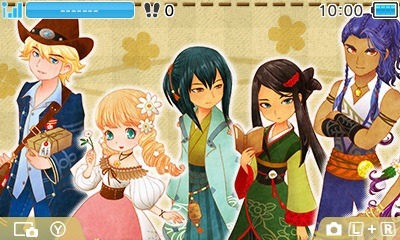
It has been a long road to releasing this extra content, from our first blog post asking for feedback to release about 9 months later. The process of translating and editing was smooth, but we hit several roadblocks during production. Still, I think that Trio of Towns is a really special entry in this long-running series (though I’m obviously a little biased), and so even though we’ve made you wait, I hope that you will enjoy this opportunity to interact with Westown, Tsuyukusa, and Lulukoko in new ways.

